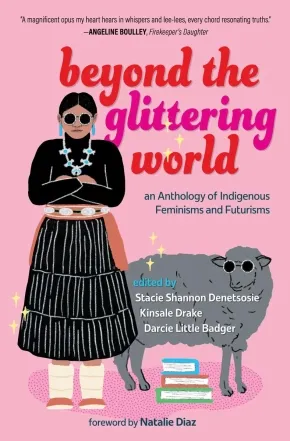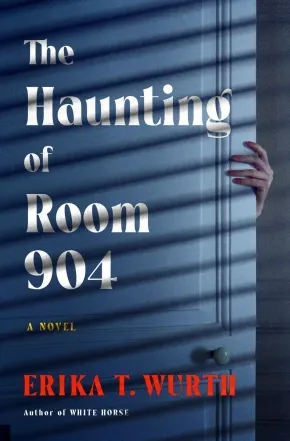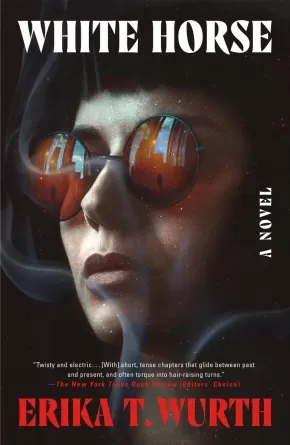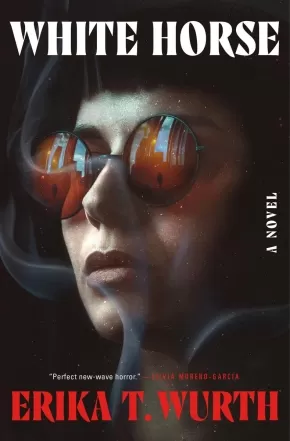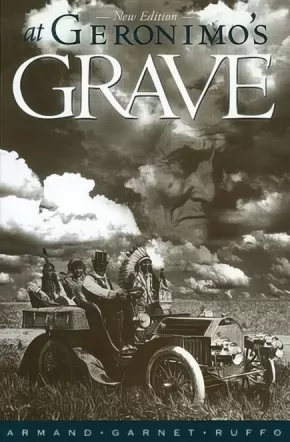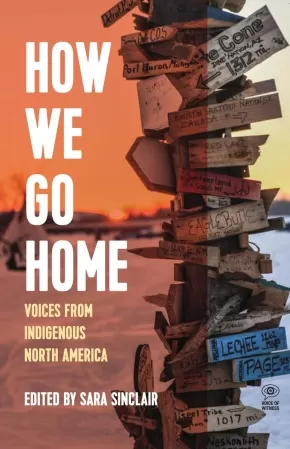Apache
Synopsis:
From adventures in Indigenous futurism to tales of first love, the stories and poems of Beyond the Glittering World proclaim and celebrate a rising generation of Native American storytellers.
Beyond the Glittering World brings together twenty emerging and established Native women writers and writers of marginalized genders, including Moniquill Blackgoose, Heid E. Erdrich, A.J. Eversole, Chelesa Hicks, and D. Daye Hunter. Immersing readers in worlds as varied as their authors, this collection presents an array of singular voices at their genre-bending, boundary-breaking, devastating, and joyous best.
Reviews
"An evocative compilation of voices pondering Indigenous futures and the shape of Indigenous love. Beyond the Glittering World holds a healthy dose of gender-bending, genre-challenging, future-hoping might. This anthology is a welcome addition to the field of Indigenous anthologies.”—DEBORAH JACKSON TAFFA, Whiskey Tender
Additional Information
240 pages | 5.25" x 8.00" | Paperback
Synopsis:
From the author of White Horse (“Twisty and electric.” —The New York Times Book Review) comes a terrifying and resonant novel about a woman who uses her unique gift to learn the truth about her sister’s death.
Olivia Becente was never supposed to have the gift. The ability to commune with the dead was the specialty of her sister, Naiche. But when Naiche dies unexpectedly and under strange circumstances, somehow Olivia suddenly can’t stop seeing and hearing from spirits.
A few years later, she’s the most in-demand paranormal investigator in Denver. She’s good at her job, but the loss of Naiche haunts her. That’s when she hears from the Brown Palace, a landmark Denver hotel. The owner can’t explain it, but every few years, a girl is found dead in room 904, no matter what room she checked into the night before. As Olivia tries to understand these disturbing deaths, the past and the present collide as Olivia’s investigation forces her to confront a mysterious and possibly dangerous cult, a vindictive journalist, betrayal by her friends, and shocking revelations about her sister’s secret life.
The Haunting of Room 904 is a paranormal thriller that is as edgy as it is heartfelt and simmers with intensity and longing. Erika T. Wurth lives up to her reputation as “a gritty new punkish outsider voice in American horror.”
Reviews
“The Haunting of Room 904 deftly mixes humor, scares, and the weight of personal and generational grief. The book is a heady, haunting, righteous, and spiritual exploration of our political mess through the lens of paranormal exploration and, sometimes even scarier, interpersonal relationships. You’ll want to follow Erika and her Olivia into any dark, creaky room.” —Paul Tremblay, New York Times bestselling author of Horror Movie and A Head Full of Ghosts
“The Haunting Of Room 904 is an electric terrifying journey into the world beyond the veil. Erika T. Wurth has created a mind bending tale of loss and love and the devastating cost of grief. You don't want to miss this!” —S. A. Cosby, author of All the Sinners Bleed and Razorblade Tears
Additional Information
320 pages | 6.12" x 9.25" | Hardcover
Synopsis:
Ela Tahoe, a runaway turned deputy sheriff, is forced to contend with a Confederate invasion of her New Mexican town three months after the conclusion of the Civil War. Ela will need to confront her heritage and past with the Apache in order to get their aid to combat this Confederate threat, leading her to look at the world from the Native American perspective once again. Conceived as a tightly paced, gut wrenching western thriller, Ela fights tooth and nail to save the lives of her townspeople and most importantly, her son.
The American Western Frontier is arguably one of the most widely misrepresented histories, rife with inaccuracies and stereotypes. Black Mi'kmaq and Anishinaabe author Tristan Jones powerfully and critically reimagines and reclaims a historical retelling of the Frontier with a focus on the historically missing Indigenous narrative. Illustrated by master sequential artist Alexander Bumbulut, The Forgotten Frontier should be on everyone's reading list.
Additional Information
140 pages | 6.00" x 9.00" | Paperback
Synopsis:
Erika T. Wurth's White Horse is a gritty, vibrant debut novel about an Indigenous woman who must face her past when she discovers a bracelet haunted by her mother’s spirit.
Some people are haunted in more ways than one.
Kari James, Urban Native, is a fan of heavy metal, ripped jeans, Stephen King novels, and dive bars. She spends most of her time at her favorite spot in Denver, the White Horse. When her cousin Debby finds an old family bracelet that once belonged to Kari’s mother, it inadvertently calls up both her mother’s ghost and a monstrous entity, and her willful ignorance about her past is no longer sustainable…
Haunted by visions of her mother and hunted by this mysterious creature, Kari must search for what happened to her mother all those years ago. Her father, permanently disabled from a car crash, can’t help her. Her Auntie Squeaker seems to know something but isn’t eager to give it all up at once. Debby’s anxious to help, but her controlling husband keeps getting in the way. Kari’s journey toward a truth long denied by both her family and law enforcement forces her to confront her dysfunctional relationships, thoughts about a friend she lost in childhood, and her desire for the one thing she’s always wanted but could never have.
Reviews
“It’s metal to the end, it’s Denver to the core, it’s Native without trying, there’s ghosts, there’s blood, there’s roller coasters, and there’s about a thousand cigarettes smoked. What else can you ask for in a novel?” —Stephen Graham Jones, author of The Only Good Indians
"This ghost story is a perfect example of new wave horror that will also satisfy fans of classic Stephen King." —Silvia Moreno-Garcia, author of The Daughter of Doctor Moreau and Mexican Gothic
Additional Information
320 pages | 5.48" x 8.25" | Paperback
Synopsis:
Erika T. Wurth's White Horse is a gritty, vibrant debut novel about an Indigenous woman who must face her past when she discovers a bracelet haunted by her mother’s spirit.
Some people are haunted in more ways than one.
Kari James, Urban Native, is a fan of heavy metal, ripped jeans, Stephen King novels, and dive bars. She spends most of her time at her favorite spot in Denver, the White Horse. When her cousin Debby finds an old family bracelet that once belonged to Kari’s mother, it inadvertently calls up both her mother’s ghost and a monstrous entity, and her willful ignorance about her past is no longer sustainable…
Haunted by visions of her mother and hunted by this mysterious creature, Kari must search for what happened to her mother all those years ago. Her father, permanently disabled from a car crash, can’t help her. Her Auntie Squeaker seems to know something but isn’t eager to give it all up at once. Debby’s anxious to help, but her controlling husband keeps getting in the way. Kari’s journey toward a truth long denied by both her family and law enforcement forces her to confront her dysfunctional relationships, thoughts about a friend she lost in childhood, and her desire for the one thing she’s always wanted but could never have.
Reviews
“It’s metal to the end, it’s Denver to the core, it’s Native without trying, there’s ghosts, there’s blood, there’s roller coasters, and there’s about a thousand cigarettes smoked. What else can you ask for in a novel?” —Stephen Graham Jones, author of The Only Good Indians
"This ghost story is a perfect example of new wave horror that will also satisfy fans of classic Stephen King." —Silvia Moreno-Garcia, author of The Daughter of Doctor Moreau and Mexican Gothic
Additional Information
320 pages | 6.55" x 9.55" | Hardcover
Synopsis:
Geronimo is probably the second-best-known Indigenous name, after Pocahontas. But the reality of the great Apache warrior's fate is little remembered. In At Geronimo's Grave, Armand Garnet Ruffo uses the Apache warrior's life as a metaphor for the lives of many of the abandoned Indigenous people on this continent. With affection and concern, award-winning poet Armand Garnet Ruffo uses straightforward language to examine the lives and experiences of people who struggle to make their way in a world that has no place for them, starting with Geronimo himself. Feared for his once-great prowess, the warrior horseman was reduced to wearing a top hat and riding in an early Ford Model T car, a grim caricature of assimilation into the dominant culture. The bitter irony of this fate echoes through the personal poems in At Geronimo's Grave. This collection is a love letter to a people trapped in the slow-moving vehicle of another culture that is taking them nowhere.
Reviews
"Armand Ruffo spins silky songs out of everyday language. They thread the separations between the dead and the living, between the heirs of Columbus and his 'Indians,' between families and their children, joining the awkward edges always with hope, often with beauty." – Daniel David Moses
Additional Information
116 pages | 6.00" x 9.00" | Paperback
Synopsis:
In myriad ways, each narrator's life has been shaped by loss, injustice, and resilience--and by the struggle of how to share space with settler nations whose essential aim is to take all that is Indigenous.
Hear from Jasilyn Charger, one of the first five people to set up camp at Standing Rock, which kickstarted a movement of Water Protectors that roused the world; Gladys Radek, a survivor of sexual violence whose niece disappeared along Canada's Highway of Tears, who became a family advocate for the National Inquiry into Missing and Murdered Indigenous Women and Girls; and Marian Naranjo, herself the subject of a secret radiation test while in high school, who went on to drive Santa Clara Pueblo toward compiling an environmental impact statement on the consequences of living next to Los Alamos National Laboratory. Theirs are stories among many of the ongoing contemporary struggles to preserve Indigenous lands and lives--and of how we go home.
Reviews
“How We Go Home is a testament to modern-day Indigenous revitalization, often in the face of the direst of circumstances. Told as firsthand accounts on the frontlines of resistance and resurgence, these life stories inspire and remind that Indigenous life is all about building a community through the gifts we offer and the stories we tell.”— Niigaan Sinclair, associate professor, Department of Native Studies at the University of Manitoba and columnist, Winnipeg Free Press
“The voices of How We Go Home are singing a chorus of love and belonging alongside the heat of resistance, and the sound of Indigenous life joyfully dances off these pages.”—Leanne Betasamosake Simpson, author of As We Have Always Done
“How We Go Home confirms that we all have stories. These stories teach us history, morality, identity, connection, empathy, understanding, and self-awareness. We hear the stories of our ancestors and they tell us who we are. We hear the stories of our heroes and they tell us what we can be." —Honourable Senator Murray Sinclair
Educator Information
Table of Contents
Editor’s Notes
Introduction (Sara Sinclair)
Executive Director’s Note (Mimi Lok)
Map
Gladys Radek, Terrace, Gitxsan / Wet’suwet’en First Nations—“When Tamara went missing, it took the breath out of me.”
Jasilyn Charger, Cheyenne River Sioux—“My son’s buried by the river. . . . I vowed to him that he’s gonna be safe, that no oil was gonna touch him.”
Wizipan Little Elk, Rosebud Lakota Tribe—“On the reservation, you have the beauty of the culture and our traditional knowledge contrasted with the reality of poverty.”
Geraldine Manson, Snuneymuxw First Nation—The nurse was trying to get me to sign a paper to put our baby, Derrick, up for adoption.”
Robert Ornelas, New York City, Lipan Apache / Ysleta del Sur Pueblo—“A part of the soul sickness for me was being ashamed . . . what we were being taught about Indians was so minimal and so negative.”
Ashley Hemmers, Fort Mojave Indian Tribe—“I didn’t work my ass off to get to Yale to be called a squaw.”
Ervin Chartrand, Selkirk, Métís/Salteaux—“They said I fit the description because I looked like six other kids with leather vests and long hair who looked Indian.”
James Favel, Winnipeg, Peguis First Nation “You’re a stakeholder because you’ve got to walk these streets every day.”
Marian Naranjo, Santa Clara Pueblo—“Indigenous peoples’ reason for being is to be the caretakers of Creator’s gifts—of the air, the water, the land.”
Blaine Wilson, Tsartlip First Nation “When I was twenty-five, thirty, there was more salmon and I was fishing every other day. Now I’m lucky to go once a week.”
Althea Guiboche, Winnipeg, Métis/Ojibwe/Salteaux “I had three babies under three years old and I was homeless.”
Vera Styres, Six Nations of the Grand River, Mohawk/Tuscarora“I was a ‘scabby, dirty little Indian.’”
Glossary
Historical Timeline of Indigenous North America
Essay: 1. The Trail of Broken Promises: US and Canadian Treaties with First Nations
Essay 2: “Indigenous Perspectives on Intergenerational Trauma”: An Interview with Johnna James
Essay 3: Indigenous Resurgence
Ten Things You Can Do
Further Reading
Acknowledgements
Additional Information
331 pages | 6.00" x 9.00" | Paperback

